Choose iconic Hiroshima or head over to Japan's least-visited prefectures. Either way, you'll encounter some seriously photogenic autumn vistas.
Chugoku is one of the most culturally rich regions of Japan. Almost every iconic aspect of Japanese culture has an embodiment here, from the country’s oldest and most sacred shrine, the Izumo Taisha, to the colorful manga kingdom of Sakaiminato in Tottori to the sobering A-Bomb Dome in Hiroshima. One-of-a-kind destinations, too, include an island reigned by rabbits and majestic ever-changing sand dunes which prove that there’s so much more to Japan than you might expect.
Five prefectures, Hiroshima, Yamaguchi, Shimane, Tottori, and Okayama, make up Chugoku. Here’s our pick of some of the top spots to experience the region in all its autumnal glory.
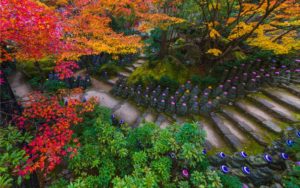
8
Miyajima
Hiroshima
The island of Miyajima, famed for the floating torii gate of Itsukushima, is considered the best koyo spot in Hiroshima. The top views in the area are said to be found in the most famous maple leaf valley in Japan, the Momijidani (Maple Valley) which runs along the base of Mt. Misen, the highest peak on the island.
- Peak season: Mid to late November
- Closest Station: Miyajimaguchi
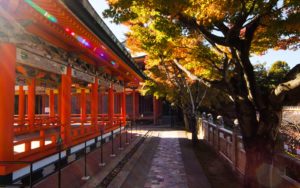
7
Kosan-ji Temple
Hiroshima
Crowds of tourists visit Kosanji Temple to see the autumn leaves every year, though the number of people shouldn’t deter you from visiting. It’s impossible not to appreciate the beauty of the stone steps leading from the main gate to the mountain gate, and the large maple trees growing in the temple precincts.
- Peak season: Mid November to early December
- Closest Port: Onomichi Ekimae Port

6
Chomonkyo Gorge
Yamaguchi
Running about 11 kilometers in the center of the Abu River, which flows into the Sea of Japan, the Chomonkyo Gorge offers distinctive scenery for any season. But it’s autumn when the gorge is at its most jaw-droppingly spectacular as the koyo colors the landscape in a painter’s palette of vivid reds, yellows, and oranges. Take it all in with a slow stroll along the path beside the river.
- Peak season: Early November to late November
- Closest Station: JR Chomonkyo Station
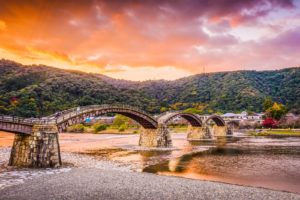
5
Kikko Park and Kintaikyo
Yamaguchi
Kikko Park is full of colorful leaves and other highlights such as the Mekatake Samurai Residence and the Iwakuni White Snake Museum. Located fairly close to Kikko Park is the picturesque Kintai Bridge, as well as Iwakuni Castle, Yamaguchi’s iconic architectural masterpiece.
- Late November to early December
- Closest Station: JR Iwakuni Station

4
Yushien Garden
Shimane
A sprawling traditional Japanese garden, Yushien is abundant with colorful leaves thanks to over 300 Japanese maples and azaleas that look stunning in autumn. The reflection of the foliage in the ponds is particularly worth seeing. At night they have a specially illuminated autumn light-up where both the leaves and lights are reflected into the surrounding water.
- Peak season: Mid to late November
- Closest Station: Matsue Station
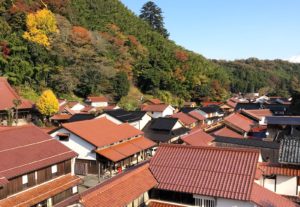
3
Iwami Ginzan
Shimane
Iwami Ginzan, a Unesco World Heritage Site famous for its historical silver mines, is beautifully colored in koyo during the autumn season. The momiji leaves in the precincts of the Kigami Shrine, known for its impressive roaring dragon ceiling, creates some very photogenic scenes in fall.
- Peak season: Late October
- Closest Station: Odashi
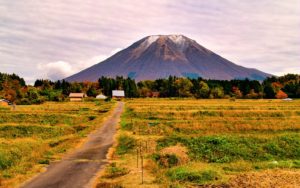
2
Mount Daisen
Tottori
Mount Daisen is the largest mountain in the Chugoku region. During koyo its forested slopes are dyed in warm colors that change little by little as you move up or around the mountain. Nearby, Daisen Temple is lit up during the weekends of the peak koyo season, shedding a different light on the surrounding maple leaves.
- Peak season: Late October to early November
- Closest Station: Kishimoto Station
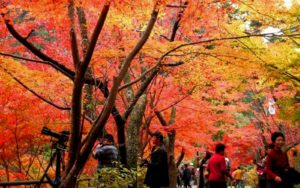

1
Okutsu Valley
Okayama
Okutsu Valley is one of the most astounding koyo spots in Okayama Prefecture. Many trees such as Japanese maple, momiji, and ginkgo color the area. An Okutsu Maple Festival will be going on from October 26 to November 10, where a family-friendly event with stores, stage performances, and a late-night light-up will be held.
- Peak season: Mid to late November
- Closest Station: Mimasaka-Sendai Station
Tag us on Instagram
If you travel to one of these spots, use #GaijinPotTravel on your Instagram photos for a chance to be featured in our Top 10 Reader’s Photos of the Month!